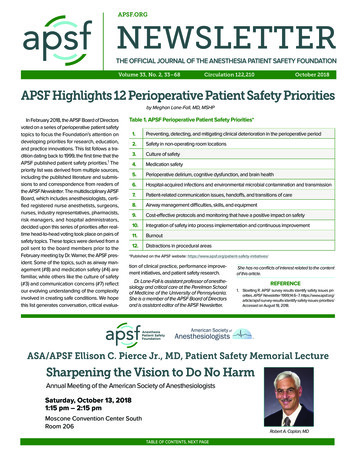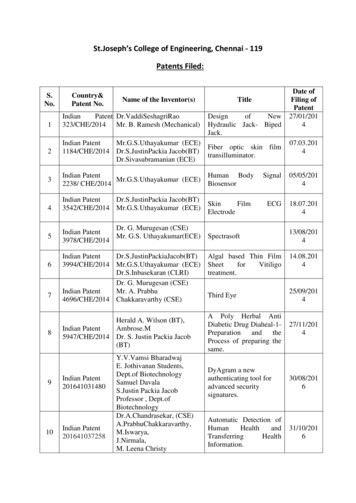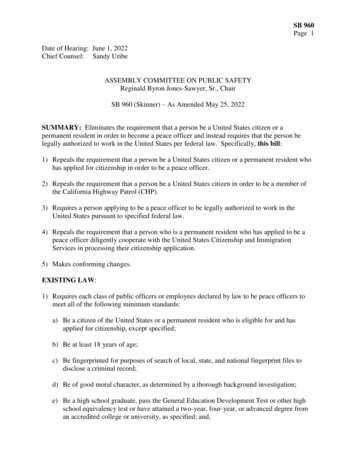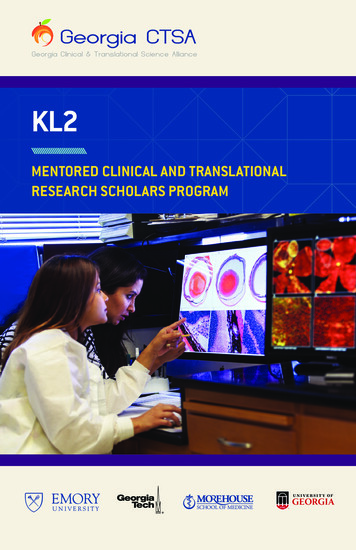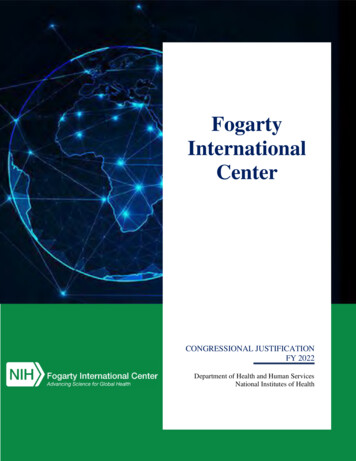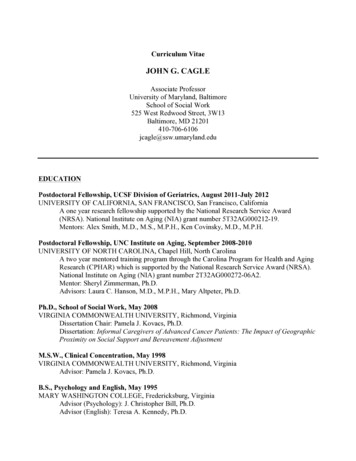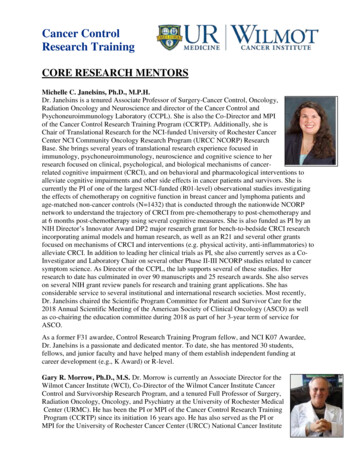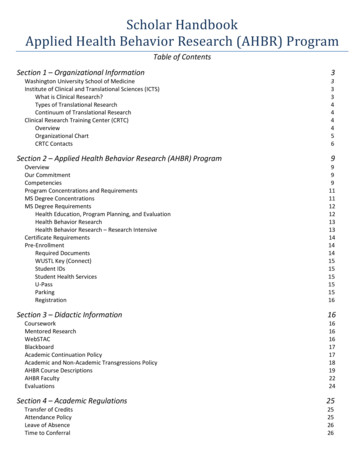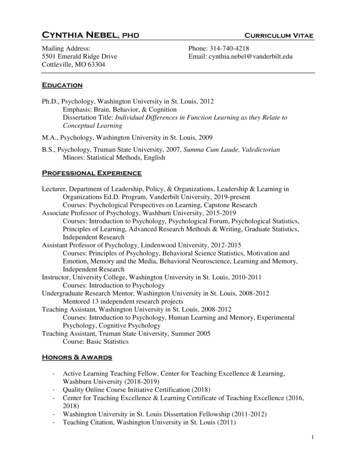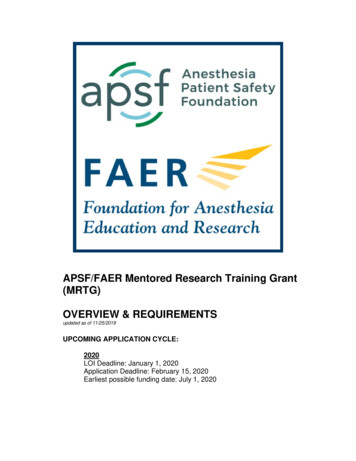
Transcription
APSF/FAER Mentored Research Training Grant(MRTG)OVERVIEW & REQUIREMENTSupdated as of 11/25/2019UPCOMING APPLICATION CYCLE:2020LOI Deadline: January 1, 2020Application Deadline: February 15, 2020Earliest possible funding date: July 1, 2020
ContentsOverviewAreas of ResearchEligibilityMentor RequirementsDepartmental/Institutional RequirementsResearch TimeFundingFAER MRTG Annual MeetingPreparing the APSF/FAER MRTG Grant Letter of Intent (LOI)Preparing the APSF/FAER MRTG Grant ApplicationA. Cover PageB. Project AbstractC. Applicant Career Plan SummaryD. Candidate BackgroundE. Research PlanF. Cited ReferencesG. Mentor’s LetterH. Facilities and ResourcesI. Human SubjectsJ. Data Management PlanK. BiosketchL. BudgetM. Chair’s Letter containing AffirmationsN. Resubmission StatementO. Career Development PlanP. Acceptance of ConditionsSubmission of APSF/FAER MRTG ApplicationDates & DeadlinesApplication InformationApplication PortalFormatting InstructionsMaterials ChecklistApplication Evaluation & Award SelectionReporting & Post-Award RequirementsInterim ReportFinal 1315151515IMPORTANT NOTE: Application Instruction Changes or Clarifications from previous versionsThe following changes have been made to the APSF/FAER MRTG application instructions and are in effect for the 2020 application cycle. If you havereviewed a previous version of the instructions, please pay special attention to these changes.1.Letter of Intent process has been added. (See page 6)2. 2,000 of the application budget must be designated for participation in the FAER MRTG Annual Meeting. (See page 5)APSF/FAER MRTG GRANT INSTRUCTIONS 11/25/2019Page 2 of 15
APSF/FAER Mentored Research Training GrantOVERVIEWThe Anesthesia Patient Safety Foundation (APSF) and the Foundation for Anesthesia Education and Research (FAER)are offering the APSF/FAER Mentored Research Training Grant (MRTG) to develop the next generation of perioperativepatient safety scientists. The intention is to fund one APSF/FAER MRTG to the sponsoring institution of a highly promisingnew perioperative patient safety scientist each year. This grant aims to help anesthesiologists develop the skills andpreliminary data they need to become independent investigators in the field of anesthesia patient safety.The APSF/FAER MRTG is a two-year, 300,000 primary investigator award (no co-investigators) that provides funding toa single sponsoring institution of an anesthesiologist faculty member who is within 10 years of their first facultyappointment. The funds may be split between the two years as necessary to complete the proposed research, with aminimum of 100,000 in each year. The APSF/FAER MRTG requires 60 percent unencumbered research and non-clinicalcareer development time during the duration of the award.AREAS OF RESEARCHFor the purposes of this grant program, patient safety is defined as the avoidance, prevention and amelioration of adverseoutcomes or injuries stemming from health care processes. The ultimate goal is that no patient is harmed in a preventablefashion by the medical care they receive. Patient safety research studies are scholarly endeavors that seek to understandthe factors that cause preventable harm to patients or that aim to study interventions to reduce that harm.Patient safety research includes the basic science of safety (e.g., fundamental understanding of how and why cliniciansthink and behave within complex healthcare systems, novel solutions to pharmacologic, procedural, or systems-basedcauses of patient injury), prospective and retrospective observational studies, and interventional (or implementation)studies. Patient safety research can be conducted in the laboratory or in real or simulated care environments. Dependingon the research objectives, the project may be hypothesis-generating or hypothesis-testing. Similarly, either qualitative orquantitative methods may be used but the choice must be justified and conducted in a rigorous state-of-the-art manner.APSF/FAER are interested in funding patient safety research directly relevant to the perioperative care of patients, as wellas chronic pain and critical care medicine. While the PI of the proposal must be a board–certified anesthesiologist, patientsafety research is usually a multi-disciplinary endeavor and this should be reflected in the proposal and in the compositionof the mentorship committee, as appropriate. A senior, experienced patient safety research mentor and a rigorous careerdevelopment plan will be essential to a successful application.For the APSF/FAER MRTG, the following types of research will not be considered: Proposals involving research on cells, tissues or animals. Proposals that do not have a clear and direct link to patient safety as defined above. Proposals involving educational initiatives except when education or training are but one component of abroader (e.g., multimodal) intervention intended to improve patient safety in an operational environment. Proposals for traditional quality improvement activities unless clearly patient safety focused and structured asrigorous scientific experiments. Studies using only retrospective data that do not have a clear and compelling link to front-line patient safetypractices.Note that data science studies which, for example, study large datasets to detect and generate hypotheses about theetiology of rare patient safety events, or those that use retrospective data to create decision support that is then evaluatedfor its ability to change clinician behavior to avoid unsafe conditions or errors will be considered.APSF/FAER MRTG GRANT INSTRUCTIONS 11/25/2019Page 3 of 15
ELIGIBILITYAt the time of the award, applicants must meet all of the following eligibility requirements: Be a U.S. citizen, permanent U.S. resident, or holder of H-1 visa with minimum of three years remaining. (A J-1 visaholder does not qualify.) Be a graduate physician with an unexpired, permanent, unconditional and unrestricted license to practice medicine orosteopathy in at least one state or jurisdiction of the U. S.* Be certified by the American Board of Anesthesiology or in the examination system**APSF/FAER will consider applicants with equivalent training or acceptance into ABA Alternative Entry Path(AEP). The acceptance letter must be provided to APSF/FAER at the time of grant application submission. Be an active member of the American Society of Anesthesiologists (ASA). Hold or be eligible for a full-time faculty position in a Department of Anesthesiology (primary appointments only) at aU.S. academic institution Have a documented interest in and aptitude for a career as a Patient Safety Investigator. Prior authorship of peerreviewed journal publications relevant to the field will be considered as one form of evidence toward this requirement. Have not previously received a federal or non-profit foundation career development award (equivalent or greater valuethan this grant) or a major investigator-initiated research grant (R21, R01 or equivalent). Recipients of this grant maynot simultaneously be receiving support from a federal source for similar patient safety research. (Should theinvestigator receive such an award during the course of this grant’s funding, the remainder of this grant’s funding willbe cancelled, and unused funds returned.)Mentor Requirements Commitment to mentor the applicant with a minimum of 5% dedicated effort. Prior evidence of successful mentorship of doctoral students, post-doctoral fellows or junior faculty. Tangible evidence of substantial experience as a patient safety (or related field) scientist including peer-reviewedextramural funding and peer-reviewed publications. Hold an accredited doctoral level degree Hold a full-time faculty appointment (preferably tenure track) in an accredited U.S. academic institution.Departmental and Institutional Requirements Commitment to provide the Applicant with at least 60% unencumbered research and non-clinical careerdevelopment time during the duration of the award. Commitment to provide the Mentor with at least 5% unencumbered time to mentor the Applicant. Unencumbered provision of the facilities and resources required for successful completion of the Applicant’sproposed Career Development Plan and Research Project, as specified in the Application and Budget.Recipients of this award agree to present their work at the first ASA annual meeting to be held after the conclusion of theirgrant, if invited. The Department Chair must commit to provide recipients with the time to present their research, ifaccepted for this presentation. Grant awardees will be reimbursed for travel costs up to 2,000 to attend and present atthe ASA annual meeting, outside of the grant funding. Grant awardees may also be invited by APSF or FAER to presenttheir work at other forums.APSF/FAER MRTG GRANT INSTRUCTIONS 11/25/2019Page 4 of 15
RESEARCH TIME During the two years of APSF/FAER-funded research, the recipient must devote a minimum commitment equivalentof 60 percent of the PI’s full-time appointment — to research and career development activities directly related to thisAPSF/FAER-funded project.FUNDING The total funding amount for the APSF/FAER Mentored Research Training Grant is 300,000.Year one will be paid between 100,000 to 200,000. Year two will be paid between 100,000 to 200,000, but not toexceed 300,000 total over the two-year grant period. Both years will be paid out at 150,000 per year unlessotherwise requested. 2,000 of the application budget must be designated for participation in the FAER MRTG Annual Meeting. Informationon the FAER MRTG Annual Meeting and related expenses will be shared with APSF/FAER MRTG award recipientsprior to each meeting.Yearly grant payments are made to the institution, not directly to the award recipient.Award renewal for the second year is contingent on the favorable review of the interim report.FAER MRTG ANNUAL MEETINGGrant recipients of the APSF/FAER MRTG award will be invited to participate in the FAER MRTG Annual Meeting, whichmay involve poster presentations and sessions on career development. This meeting is highly encouraged as it aims tocreate a community of early-stage investigators and is a career development opportunity. 2,000 of the applicationbudget must be designated for this purpose. Funds in this category must be spent on meeting related expenses,guidelines on funds and any restrictions will be provided within the invitation from FAER staff. Meeting specifics (dates,location, sessions etc.) will be shared with grantees as they become available.APSF/FAER MRTG GRANT INSTRUCTIONS 11/25/2019Page 5 of 15
1. Preparing the APSF/FAER MRTG Grant Letter of IntentTo apply, applicants will first submit a three-page letter of intent (LOI), with the understanding that full research proposalmay be developed if selected as one of the finalists.The format should be a one-page cover letter and a two-page project description.Letters of intent for the APSF/FAER MRTG award will be accepted from December 1, 2019 through January 1, 2020 (onemonth). LOI’s must be submitted through FAER’s online grant portal.LOI’s will be reviewed by members of the APSF/FAER MRTG Grant Review Committee. Applicants will be notified byFAER staff after a review of the LOI if they have been selected to submit a full research application.The LOI should be organized as follows: COVER LETTER - On letterhead of the institution that is sponsoring the investigation.oo Title and Principal Investigator (PI): Include title of the project, the credentials, title, office address, andemail address of the PI, and the PI’s primary institutional affiliation. List only one person as the PI.Indicate if there are other participating institutions, designate the time period for which funds will berequested for, and identify the members of the research team including any co-investigators and mentors.PROJECT DESCRIPTION (maximum 2 pages) - The project description must be no longer than two singlesided pages, single-spaced, with a 12-pt. font size and with 1-inch margins on all sides.o A descriptive title of the proposed research.o Executive Summary: Summarize the project. Limit to one paragraph.o Background: Describe the problem, existing knowledge about it, its importance to the APSF/FAERfunding priorities. Limit to 1 paragraph.o Specific Aims: Describe what you are proposing to accomplish toward addressing the problem, i.e., whatare your goals and objectives? What hypothesis will be tested?o Methods: Describe the methods that will be employed to study the primary hypothesis. Be as specific aspossible without unnecessary detail. This section is important and should be detailed enough to explainthe methods that are being applied for analysis of the primary endpoint.o Impact: Describe how you expect the results will be used and what impact could they have in addressingthe problem.2. Preparing the APSF/FAER MRTG Grant ApplicationIf an applicant is selected to submit a full research application following the LOI process, they will be notified by FAER. Ifselected to submit a complete research application, the following instructions and guidelines should be used to completethe application.NOTE: Applicants must be selected during the LOI process in order to submit an application.A. COVER PAGEThe cover page should include general application information. It must include the following sections. Title of Research Project Applicant (Principal Investigator) Information: Name of applicant including academic degrees, office address,phone number, fax number and e-mail address. Mentor Information: Names and affiliations of the applicant’s mentor Other Investigators or Consultants: Names and affiliations of any other investigators or consultants Department Chair Information: Name, office address, and phone number of departmental chairpersonAPSF/FAER MRTG GRANT INSTRUCTIONS 11/25/2019Page 6 of 15
Institution Information: Sponsoring institution and name, office address, phone number and e-mail address ofthe responsible institutional financial officer Project Dates: Start and end dates of proposed projectB. PROJECT ABSTRACT ( 100 words)The Abstract should explain the proposed research study in language understandable to the average clinicalanesthesiologist. The abstract should state the broad long-term objectives and specific aims of the project, its relationshipto anesthesiology, as well as the research design and methods. The abstract should be a succinct and accuratedescription of the proposed work that can be understood when read apart from the application. The abstract will be usedprimarily for promotional purposes.C. APPLICANT CAREER PLAN SUMMARY ( 250 words)The Career Plan Summary should explain the applicant’s current situation, proposed career development activities, andfuture career plans in language understandable to the average clinical anesthesiologist. The Career Plan Summary mustinclude at least the following elements: Applicant’s preferred full name and degrees. The submitting academic institution (and medical center if different). The preferred full name, degrees, and primary affiliations of the Applicant’s mentor The title of the research project and a summary sentence about the proposed project. The patient safety topic area(s) and research methods that will be the focus of the Applicant’s career. The Applicant’s long-term goals for improving perioperative patient safety.D. CANDIDATE BACKGROUND ( 3 pages)The candidate background should include the following elements: Career Goals and Objectives (include specific plans for post-award research activities, extra-mural funding andfurther career development) Career Development/Training Activities During Award Period Training in the Responsible Conduct of Research Timeline of Proposed ActivitiesE. RESEARCH PLAN ( 8 pages)The research plan is the core of the application. Particularly, because of page limitations, the research plan should bedeveloped in conjunction with the applicant’s mentor(s). It must include the following sections. The research plan shouldinclude the following elements: Significance: Why is the proposed research important? How will it advance our understanding of andimprovements in patient safety? How will it advance the Applicant’s long-term goals for improving patientsafety? This section typically includes evidence that the Applicant has a strong fundamental understanding ofthe relevant patient safety knowledge and evidence. Innovation Approach: The Approach must include the following sections presented in the following order:APSF/FAER MRTG GRANT INSTRUCTIONS 11/25/2019Page 7 of 15
oHypothesis and Specific Aims: After a brief introduction, this section must articulate the Aims of thestudy and the hypotheses to be tested. All hypotheses must be stated in a way that they can be testedwith empiric data. Note that some types of patient safety research studies may appropriately behypothesis generating rather than hypothesis testing. In this circumstance, Specific Aims andassociated Research Questions would be included in this section.oDetailed Proposed Methods: This section must include a detailed description of the proposedexperimental design, the numbers and nature of study participants, the procedures to be employed, theindependent variables to be manipulated, the dependent variables to be measured, and any covariatesthat will be included. The description should include a rationale for the choice of each dependentvariable.oData Analysis Plan and Sample Size Justification: This section must include a detailed analyticalplan and a rigorous justification for the proposed sample size with sufficient detail to convince thereviewers of a low likelihood of either Type 1 or Type 2 errors. In addition to total sample size, the planshould include a statement of the number of eligible subjects in the study site’s patient population andthe feasibility of adequate recruitment during the study period. It would be prudent to provide evidenceof the initial and planned ongoing involvement of an experienced biostatistician. Note that investigatorsproposing use of qualitative or mixed methods will be held to equivalently high standards of rigor.oInterpretation of Results: This section should describe how the results will address the statedhypotheses, how alternative findings will be interpreted, what the investigator will do if the findings donot confirm the original hypotheses (this is especially important in multi-part studies or aims thatdepend on each other), and the patient safety significance of the expected results.oStudy Limitations: This critical section must provide a comprehensive and realistic description of thestudy limitations and the methods by which the investigators have (or will) mitigate these limitations.oFuture Directions: This brief section should describe what future studies are anticipated to flow fromAPSF’s investment in the conduct of the proposed study and why such future studies are important tolong-term improvements in patient safety. Do not duplicate content in the Significance section above.oProject Management and Detailed Timeline: This section must describe how the PI will organize,plan, and oversee the proposed research. When a team of scientists will be involved, the ProjectManagement plan should describe how the team will communicate and interact. Finally, this sectionshould describe how the team will assure that the project is completed on time and within the proposedbudget. The project timeline should be presented in a Gantt chart that includes specific detailedmilestones and deliverables.F. CITED REFERENCES ( 2 pages)This section should provide evidence that the Applicant is very familiar with the most current relevant literature and willtake a rigorous and scholarly approach to the proposed research. Please cite only the most relevant and importantliterature. References should be cited in the order in which they appear in the Research Plan and should use the formatapproved by the journal Anesthesiology.G. MENTOR’S LETTER ( 4 pages) The mentor’s letter may be the most critical part of the application. The letter must be a PDF scan of a signedoriginal on institutional stationary. The mentor’s letter must contain all of the following elements: Training and Research Career Development Plan Mentoring Plan Progress Assessment Anticipated Sources of Research Project Support Nature and Extent of Supervision and MentoringAPSF/FAER MRTG GRANT INSTRUCTIONS 11/25/2019Page 8 of 15
Anticipated Non-Award Activities Plan for Transition to Independence Mentor Qualifications Mentoring HistoryH. FACILITIES AND RESOURCES ( 2 pages)This section describes the readily available relevant institutional facilities and resources that will support the Applicant’scareer development and proposed research project. Please provide evidence (i.e., specific examples) of how theinstitution has invested in and supported prior patient safety research projects that have led to peer-reviewed journalpublications. The Review Committee considers the institutional infrastructure very important to the success of new patientsafety investigators.I. HUMAN SUBJECTS ( 3 pages)This section should succinctly address all of the elements typically found in an institutional human subjects committee (orIRB) application.Provide a letter of approval from the appropriate institutional human or animal use review committee.If this study does not require this approval, or if the application is submitted before approval is obtained, provide a letter ofexplanation. Notification of institutional approval must be received in the FAER office prior to any award payment beingmade.J. DATA MANAGEMENT PLAN (no page limit)Describe how your data will be collected, handled, stored and analyzed with respect to HIPPA compliance, participant andpatient privacy, confidentiality, and data security.IMPORTANT NOTE: By the time of application review, the Applicant must provide APSF with evidence that they haveundergone and are current with their institution’s approved human subjects/responsible conduct of research training.FDA and Other Regulatory Compliance (if applicable). If medical devices are to be used on patients in the proposedstudy in ways that are not currently FDA-approved, the investigators must confer with their IRB regarding the need for anIDE. Similarly, if drugs are to be used in the proposed study in ways that are not currently FDA-approved, theinvestigators must confer with their IRB regarding the need for an IND. The relevant issues should be addressed in thissection.K. BIOSKETCH ( 4 pages each)Applicant and Mentor: Use the latest version of the current NIH biosketch template. (The template is available atFAER.org/research-grants/apply). Submit one biosketch for the Applicant and one for each mentor.For the applicant and the mentor(s), the personal statement is an important part of the biosketch. Information providedwithin the biosketch personal statement is considered during grant review. The personal statement should be tailored tothe specific grant application and used to convey information about your relevant qualifications and experience related toyour role in the grant. The personal statement is most often written in the first person. For applicants, it shoulddemonstrate your understanding of the project and how it will benefit your career, and for mentors, it should demonstrateyour understanding of the project and how it will benefit your mentee’s career.L. BUDGET (no page limit)APSF/FAER MRTG GRANT INSTRUCTIONS 11/25/2019Page 9 of 15
As a part of the APSF/FAER MRTG grant application, the applicant must provide a detailed budget and justification ofexpenses using the APSF/FAER MRTG budget template. (Budget templates are available instructionsforms) Budget for each individual year and in total. Itemized budget justification. The application should provide sufficient explanation and rationale for eachbudget item to fully justify the proposed expenditure. Please explain all changes in item-level budgeted amountsbetween Years 1 and 2. Budgeting limitations. The following items can NOT be paid for from funds provided by this grant:oConstruction, Renovations, or Furniture.oCapital equipment exceeding 10,000.oApplicant coursework, training or career development materials that exceed 10,000.oAny item considered an Indirect Cost by any Federal granting agency.IMPORTANT NOTE: No indirect cost will be covered by this grant.IMPORTANT NOTE: Violations of any of this grant’s financial stipulations will be grounds forimmediate revocation of the award and full repayment of the total award by the sponsoringinstitution.Additional Budget GuidelinesCATEGORYSalary Equipment SuppliesTravel Tuition OtherExpenses REQUIREMENTSThe total salary for the applicant and all salary sources must be specified in thebudget.Salary support for the mentor(s) is not allowed.Research staff salary support is allowed with appropriate justification.This grant is to be used primarily for ongoing research expenses. Major equipmentpurchases are considered to be the responsibility of the applicant’s Department.The award may be used for minor equipment expenses related to the researchproject, with sufficient justification, at the discretion of APSF/FAER.(Majorequipment is defined as an article of tangible nonexpendable property that has auseful life of more than 1 year and an acquisition cost that equals or exceeds 10,000.)Expenses for computers not directly justified by the research are not allowed.The award may be used for supply expenses related to the research project. 2,000 of the application budget must be designated for participation in the FAERMRTG Annual Meeting. No other travel is allowed in the budget.APSF/FAER funds are intended to be directed primarily to research costs.However, requests for tuition support will be considered on an individual basis.In the event that tuition or course fees are proposed in a grant budget, the applicantshould describe in detail:o How the activity will specifically contribute to the success of the researchproject;o The need for external rather than institutional funding.Incremental patient costs directly related to the study are allowed.Indirect costs are not allowed.Secretarial or administrative costs are not allowed.APSF/FAER MRTG GRANT INSTRUCTIONS 11/25/2019Page 10 of 15
Alterations and renovations are not allowed.M. CHAIR LETTER CONTAINING AFFIRMATIONS ( 3 pages)This letter must be from the Chair of the sponsoring institution’s Department of Anesthesiology. The letter must be a PDFscan of a signed original on institutional stationary. The letter must include the following elements:1. Application’s significance to Anesthesiology;2. Guaranteed regular (preferably tenure) track faculty appointment of the Applicant by the start of the second yearof funding;3. Departmental commitment to provide to the Applicant 60% research and academic time for the two-year projectduration;4. Departmental commitment to provide a minimum of 5% dedicated effort of the designated mentor;5. Resource availability and commitment;6. Internal peer review completed;7. Management of awarded funds;a. Commitment to provide specified facilities and resourcesb. Return of unused funds to APSF/FAER.NOTE: No Appendices or supplemental material will be accepted.N. RESUBMISSION STATEMENT ( 2 pages)If you have previously submitted any research proposal to APSF or FAER, you must include a resubmission statementwithin your application. If you previously received an APSF or FAER grant, indicate what type of grant and the years offunding.If you are submitting a revised application, the resubmission statement should provide a summary of the differencesbetween this and the previous application. It should address the critiques of the original application point by point.Applicants may submit up to two resubmissions of a revised research grant proposal.If you are reapplying to APSF or FAER with a completely different research protocol, the resubmission statement shouldindicate how and why this project differs from the previous application.O. CAREER DEVELOPMENT PLAN ( 2 pages)The career development plan should be written by the applicant — in the applicant’s voice — with input from the primaryresearch mentor or mentorship team.Within the career development plan, the applicant should describe their motivation and commitment to a research careerand should outline short-term and long-term career objectives. The career development plan should show clearly how theproposed research will prepare the applicant for an independent career as a physician-scientist. The plan should describethose specific elements planned for the training period, including formal or didactic training through courses, classwork,and participation in institutional research training (e.g. CTSA research training program).To prepare to write the career development plan, the applicant should conduct a realistic self-assessment to identifyresearch abilities and skills, as well as strengths and areas that need development. Along with the mentor(s), theapplicant should discuss current skills and strengths and compare them with those needed for the research career choice.APSF/FAER MRTG GRANT INSTRUCTIONS 11/25/2019Page 11 of 15
The career development plan should outline the outcomes of the self-assessment and should define the approaches thatthe applicant will use to obtain the specific skills and strengths (e.g., courses, technical skills, teaching, supervision)together with anticipated time frames.P. ACCEPTANCE OF CONDITIONS FORM ( 1 page)As a part of the APSF/FAER MRTG grant application, the applicant must provide a signed APSF/FAER Acceptance ofConditions form. This form must be signed by the applicant, mentor, and department chair. (Acceptance
Grant recipients of the APSF/FAER MRTG award will be invited to participate in the FAER MRTG Annual Meeting, which may involve poster presentations and sessions on career development. This meeting is highly encouraged as it aims to create a community of early-stage investigators and is a career development opportunity. 2,000 of the application
